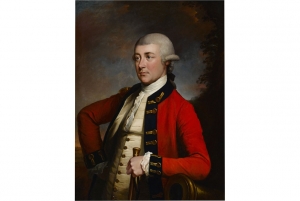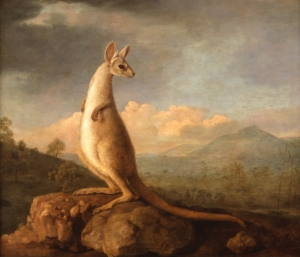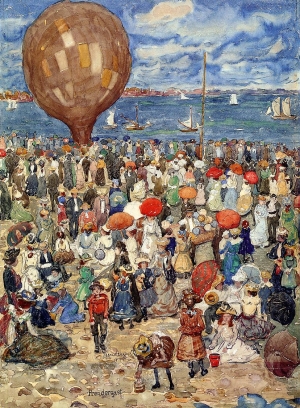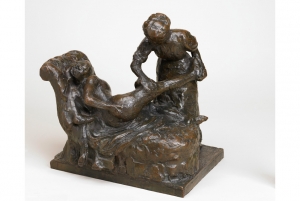|
Displaying items by tag: painter
Paris’s Picasso museum, which houses one of the world’s most extensive collections of the Spanish painter’s work, is set to reopen its doors in September after being closed for five years for renovation, the culture ministry announced Sunday.
The popular museum was originally to be closed for a two-year renovation and the delay has caused controversy, with the painter's son Claude Picasso on Friday accusing the French government of indifference and saying he was "scandalised and very worried" about the future of the museum.

On May 21, a long-lost portrait of Captain Gabriel Maturin by John Singleton Copley will be offered during Bonhams’ American Art sale in New York. The work was painted in 1771 during Copley’s six-month sojourn in New York City, four years prior to the American Revolution. The portrait, which was believed to have been lost until it was located in the U.S. and authenticated in 2011, is expected to fetch between $500,000 and $700,000.
In 1768, Copley painted a portrait of New York-based Major General Thomas Gage, the Commander in Chief of His Majesty’s Armed Forces in America. The work helped establish Copley among General Gage’s team and eventually led to a commission from Captain Gabriel Maturin, General Gage’s Chief of Staff.
Copley, the foremost artist in colonial America, rarely traveled outside of Boston. In fact, prior to his permanent relocation to Europe in 1774, his brief stay in New York City was the artist’s only venture outside of the New England city. Copley’s portrait of Captain Gabriel Maturin is one of approximately 25 portraits painted during the artist’s stay in New York.

“American Chronicles: The Art of Norman Rockwell” is currently on view at the Newark Museum in Newark, New Jersey. The sweeping exhibition, which is organized by the Norman Rockwell Museum in Stockbridge, Massachusetts, focuses on the work of the widely popular 20th century painter and illustrator, Norman Rockwell. Rockwell is best known for his archetypical portrayals of American life as well as his cover illustrations for “The Saturday Evening Post” magazine.
“American Chronicles” is a traveling exhibition that presents 50 original Rockwell paintings as well as the 323 covers he created for “The Saturday Evening Post.” The show features some of Rockwell’s most recognized images including “Triple Self-Portrait,” “Girl at Mirror,” and “Going and Coming” as well as portraits of Dwight D. Eisenhower and John F. Kennedy. The exhibition includes a number of works from Rockwell’s archives such as preliminary sketches, color studies, photographs, letters, manuscripts, and detailed drawings.
“American Chronicles” offers visitors a glimpse into Rockwell’s artistic process and illustrates how he came to be the visual interpreter of day-to-day life in post-World War II America. The exhibition will remain on view at the Newark Museum through May 26, 2014. It will then travel to the Fondazione Roma-Arte Musei in Rome (November 10, 2014-February 8, 2014) and the Brigham Young University Museum of Art in Provo, Utah (November 19, 2015-February 13, 2016).
London’s Victoria and Albert Museum announced that they discovered a previously unknown oil sketch by English Romantic painter John Constable. The sketch of trees, which dates back to 1821 or 1822, was found tucked beneath another work by the artist, “Branch Hill Pond: Hampstead.” Conservators had removed the painting’s lining while preparing for the upcoming exhibition, “Constable: The Making of a Master.”
Constable’s daughter donated the contents of the artist’s studio -- including 92 oil sketches, 297 drawings and watercolors, and 3 sketchbooks -- to the Victoria and Albert Museum in 1888. The recently discovered sketch is currently on view at the institution.
The Frick Collection in New York has named Xavier F. Salomon chief curator of the museum, filling a vacant spot left by Colin B. Bailey who departed the institution in June to become director of the Fine Arts Museums of San Francisco.
Prior to joining the Frick, Salomon spent three years at the Metropolitan Museum of Art as the curator of Southern Baroque paintings and before that, he was chief curator of London’s Dulwich Picture Gallery. Salomon is an expert in the work of the Italian Renaissance painter Paolo Veronese and the collecting and patronage of the cardinals in Rome during the 17th century.
Salomon will assume his new role at the Frick in January 2014.

In February 2013, the British government placed a temporary export ban on two important oil paintings by George Stubbs (1724-1806), an English painter best know for his depictions of horses. The works, which went on display at London’s Royal Academy in 1773, gave the British public their first glimpse of a kangaroo and a dingo.
The export ban went into effect shortly after it was decided by the Reviewing Committee on the Export of Works of Art and Objects of Cultural Interest that the paintings were of outstanding significance for the study of 18th century exploration of Australia and the public dissemination of knowledge during the Enlightenment. The point of the export ban was to grant UK museums enough time to raise the £5.5 million necessary to keep the Stubbs paintings in the UK.
The National Maritime Museum in London has launched a £1.5 million bid to acquire Kongouro from New Holland (Kangaroo) and Portrait of a Large Dog (Dingo). The museum has already secured £3.2 million from the Heritage Lottery Fund and an additional £200,000 from the Art Fund. If the Maritime Museum’s appeal is successful, the paintings will initially go on display in the Queen’s House in Greenwich in 2014.
Stubbs created the Kongouro and Portrait of a Large Dog based on spoken accounts, as he had never actually seen the animals. It is believed that Sir Joseph Banks commissioned the paintings after assisting in Captain James Cook’s voyage to the Pacific. Following their completion, Stubbs won praise for bringing the likenesses of the foreign animals to the British public for the first time.

Maurice Prendergast: By the Sea, which is now on view at the Bowdoin College Museum of Art in Brunswick, Maine, explores the artist’s lifelong fascination with the sea. Maurice Prendergast, a pioneering post-Impressionist painter, spent much of the late 19th century and early 20th century capturing modern life on the coast of New England.
By the Sea is the first retrospective of Prendergast’s oeuvre in over two decades. The exhibition presents more than 90 works in a variety of media from over 30 public and private collections in addition to Bowdoin College Museum of Art’s own holdings. The exhibition traces the development of Prendergast’s highly personal style, which is recognized for its use of jewel-like colors and pattern-like compositions containing flattened, free-form figures. The exhibition also includes Prendergast’s sketchbooks and oil studies, allowing visitors to see into the Modernist artist’s creative process.
Highlights include the watercolor The Balloon, which is part of a private collection and has not been included in earlier Prendergast retrospectives; St. Malo, a bright watercolor on loan from the Williams College Museum of Art, which was lauded as one of the first American introductions of the bold European Post-Impressionist avant-garde; and a number of works that the artist contributed to the seminal Armory Show of 1913 (also known as the International Exhibition of Modern Art).
Maurice Prendergast: By the Sea will be on view at the Bowdoin College Museum of Art through October 13, 2013.
The Museum of Fine Arts in Boston presents the exhibition Audubon’s Birds, Audubon’s Words. The show features approximately 30 prints from the museum’s copy of John James Audubon’s seminal work The Birds of America alongside the prose he originally wrote for the book.
The naturalist and painter is best known for his life-size, hand-colored prints illustrating the wide variety of birds in North America. The MFA’s exhibition aims to bring attention to Audubon’s undervalued text, which he original wrote to describe each bird he portrayed in Birds of America. However, the first edition of the book was printed between 1827 and 1838 without words. The MFA’s presentation of Audubon’s prose allows patrons the chance to read first-hand accounts of the methods the artist used to depict the birds and the trials associated with his substantial project.
Audubon’s Birds, Audubon’s Words will be on view at the MFA through May 11, 2014.
Winthrop Chandler (1747–1790) is the first known American artist to paint American landscapes that have survived. The artists who painted American landscapes prior to Chandler are either unknown, were not born in America, or if they were, did not paint American scenes.1 An American, Sibyl Huntington May, painted an overmantel with people, animals, and her husband’s church, for his parsonage in Haddam, Connecticut, sometime after its completion in 1758.2 However, she only painted a single work.

Edgar Degas’ (1834-1917) La Masseuse (The Masseuse), which was once owned by the German-born British painter Lucien Freud (1922-2011), has been given to the Walker Art Gallery as part of the British government’s Acceptance in Lieu (AiL) of law. The AiL is a provision under which inheritance tax debts can be written off in exchange for the acquisition of objects of national importance.
The Degas sculpture was one of three works by Degas bequeathed to England following Freud’s death. The Walker Art Gallery, which is located in Liverpool and houses one of the largest art collections in England outside of London, was granted the sculpture after a competitive process with other UK museums and galleries. La Masseuse, Degas’ only two-figure sculpture, will join the artist’s painting Woman Ironing at the Walker.
Xanthe Brooke, Curator of European Art at the Walker Art Gallery, said, ‘We’re very grateful to Arts Council England for allocating the sculpture to the Walker Art Gallery, where it will be appreciated by an enthusiastic and diverse audience.”
|
|
|
|
|